Historic sites of chemistry
With the Historic Sites of Chemistry program , the Society of German Chemists (GDCh) honors achievements of historical importance in chemistry . The places of activity of well-known scientists are awarded with a memorial plaque as places of remembrance as part of a solemn act. The aim of the program is to raise public awareness of the cultural heritage and historical roots of chemistry.
List of Historic Places
| year | Person and place | description | Image of the plaque | Image of the site |
|---|---|---|---|---|
| 1999 | Hermann Staudinger in Freiburg | The Institute for Macromolecular Chemistry at the Albert-Ludwigs-University Freiburg / Breisgau. |  |
 Institute for Macromolecular Chemistry at the University of Freiburg, Hermann Staudinger Haus 48 ° 0 ′ 8 ″ N, 7 ° 50 ′ 44 ″ E |
| 2002 | Fritz Straßmann in Mainz | The Institute for Nuclear Chemistry at Johannes Gutenberg University Mainz . | 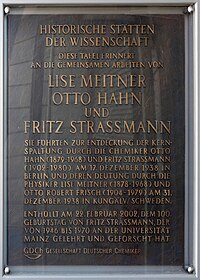 |
 Institute for Nuclear Chemistry 49 ° 59 ′ 33 ″ N, 8 ° 14 ′ 15 ″ E |
| 2003 | Justus von Liebig in Giessen | On May 16, 2003, on the occasion of Justus Liebig's 200th birthday, his former laboratory was named a Historic Site of Chemistry. Today's Liebig Museum in Gießen was originally a guard house of a barracks and was gradually rebuilt by and for Liebig during his time as a professor at what was then Ludwig University from 1824–1852. While the professor was still doing research in a dark room by an open fireplace in the “old laboratory”, at the end of Liebig's time there were closed fume cupboards and a comparatively modern lecture hall in which experiments for the training of students could be demonstrated. At Robert Sommer's endeavor , the building, which had largely remained in its original state, was acquired in 1912 and opened as a museum in 1920. The appreciation brochure of the GDCh particularly emphasizes how popular and respected Liebig was with his students because he supervised them personally and applied a new teaching method by explaining and justifying experiments carried out during the lecture. Liebig is therefore also considered a study reformer. In addition to many Germans, 221 from 11 other countries studied with him. Have become famous August Wilhelm von Hofmann , Friedrich August Kekule , Max von Pettenkofer , Wilhelm Henneberg , Carl Schmidt , Lyon Playfair , Ascanio Sobrero and Eben Norton Horsford . |
 |
 Liebig Museum in Gießen (front left the memorial plaque) 50 ° 34 ′ 51 ″ N, 8 ° 39 ′ 59 ″ E |
| 2004 | Clemens Winkler in Freiberg | On October 20 and 21, 2004, the research facility (and house) of Clemens Alexander Winkler, the old chemical institute of the former Royal Saxon Bergakademie Freiberg, today the Technical University Bergakademie Freiberg , received an award. There, Winkler carried out pioneering work in the fields of inorganic, analytical and technical chemistry . This included the development of a process for flue gas desulphurization and the discovery of the element germanium . | 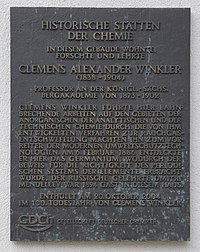 |
 Clemens Winkler Memorial TU Freiberg, Brennhausgasse 5 50 ° 55 ′ 5 ″ N, 13 ° 20 ′ 27 ″ E |
| 2005 | Wilhelm Ostwald in Großbothen | On September 1, 2005, the work of Wilhelm Ostwald in the field of catalysis, chemical equilibrium and reaction speeds at the Haus "Energie" estate in Großbothen near Leipzig was honored. |  |
 Energy house in Wilhelm-Ostwald-Park in Großbothen / Saxony 51 ° 11 ′ 31 ″ N, 12 ° 44 ′ 36 ″ E |
| 2006 | Hans Meerwein in Marburg | On September 15, 2006, Hans Meerwein was posthumously honored as doyen of Marburg chemistry with a bronze plaque in the entrance area of the former chemical institute of the Philipps University of Marburg on Bahnhofstrasse. In this institute, Hans Meerwein carried out fundamental work on synthetic and mechanistic organic chemistry . With the discovery of the carbenium ions , he was able to help clarify the mechanisms of several organic chemical reactions. This is why the reactions he investigated now bear his name (see Meerwein-Reduction , Meerwein-Ponndorf-Verley-Reduction ). The building of the former Chemical Institute of the Philipps University of Marburg now houses the Chemikum as well as the Marburg University Association, a mammography project and working groups from Foto Marburg . The new chemical institute on the Lahnberge campus has been located on Hans-Meerwein-Straße, named after the scientist, right from the start. |
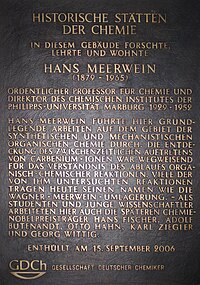 |
 Former chemical institute of the Philipps University of Marburg 50 ° 49 ′ 0 ″ N, 8 ° 46 ′ 12 ″ E |
| 2008 | Karl Ziegler in Mülheim an der Ruhr | On May 8, 2008, the work of Karl Ziegler at the Max Planck Institute for Coal Research in Mülheim an der Ruhr in the field of organometallic chemistry and catalysis , especially his work on the production of polyethylene at normal pressure and room temperature, was honored. | 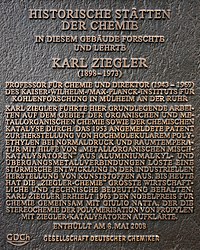 |
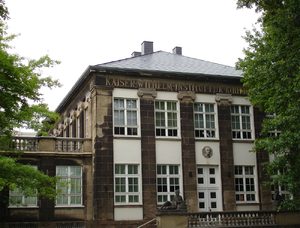 Old building of the Max Planck Institute for Coal Research 51 ° 25 ′ 0 ″ N, 6 ° 53 ′ 7 ″ E |
| 2009 | Ernst Beckmann in Leipzig | On May 15, 2009, the Old Chemical Institute, formerly the “Laboratory for Applied Chemistry”, at the University of Leipzig was honored as Ernst Beckmann's place of work. In addition to Beckmann's work in physical and organic chemistry, the plaque also commemorates the work of other important chemists, such as Wilhelm Ostwald , Svante Arrhenius , Walther Nernst , Berthold Rassow , Karl Friedrich Bonhoeffer and Leopold Wolf . The panel was unveiled as part of the 600th anniversary of the Leipzig University, which was founded in 1409. |
 Memorial plaque for Ernst Beckmann and Wilhelm Ostwald |
 Former Laboratory for Applied Chemistry 51 ° 19 ′ 56 ″ N, 12 ° 23 ′ 13 ″ E |
| 2010 | Wolfen Industry and Film Museum | The Wolfen film factory was founded by Agfa in 1909 and taken over by IG Farben in 1925 . In 1936 the first color film , a film with three layers of color, the Agfacolor Neu, was produced there. The color film is a development by Gustav Wilmanns and Wilhelm Schneider . |
|
 Industry and Film Museum 51 ° 39 ′ 24 ″ N, 12 ° 15 ′ 45 ″ E |
| 2011 | Robert Wilhelm Bunsen in Heidelberg | On October 12, 2011, the former chemistry laboratory in Akademiestraße / Plöck 55 was recognized as the place of work by Robert Wilhelm Bunsen . The occasion was the 200th birthday of the chemist, who is considered one of the pioneers of physical chemistry. Together with Gustav Kirchhoff, he developed spectroscopy , which enabled the discovery of the elements cesium and rubidium . The building, built in 1854/55, was equipped with heating, running water, gas and electricity and was considered the most modern chemical laboratory in Europe at the time. In the period from 1852 to 1889 Robert Bunsen was director of the chemical laboratory at Heidelberg University. The building, which was used as part of the Chemical Institute until the end of the 1950s, now houses the Institute for German as a Foreign Language Philology. |
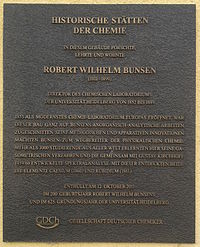 |
 Old chemistry building at Heidelberg University 49 ° 24 ′ 34 ″ N, 8 ° 41 ′ 53 ″ E |
| 2012 | Former salicylic acid factory and later chemical factory Dr. F. von Heyden, Radebeul | The former salicylic acid factory and later chemical factory Dr. F. von Heyden, Radebeul , is the former place of work of Jacob Friedrich von Heyden , Adolf Wilhelm Hermann Kolbe , Rudolf Wilhelm Schmitt , Bruno Richard Seifert , Richard Gustav Müller . Kolbe recognized the fungicidal and antibacterial effects of salicylic acid, for which he found two synthetic routes; the first by passing carbon dioxide over phenol ; the second method was suitable for industrial production: conversion of heated sodium phenolate with carbon dioxide. Von Heyden manufactured it using this process from 1874. Schmitt and his student Seifert explained the mechanism of the reaction, which led to the fact that the carbon dioxide was then applied under pressure to increase the yield. Richard Seifert also developed the recipe for Odol , which was then manufactured and successfully marketed by August Lingner . Richard Müller is known as the "German father of silicone chemistry ". He joined the von Heyden company in 1934 and received the first silicone from his so-called direct synthesis in 1940: when CH 3 Cl is passed over a copper-silicon alloy when heated, mainly dimethyldichlorosilane is formed , the hydrolysis products of which result in polysiloxane plastics (silicones) when condensed . |
 |
 Meißner Straße 35, the location marked in 2012 51 ° 5 ′ 49 ″ N, 13 ° 41 ′ 35 ″ E |
| 2013 | Fresenius, Wiesbaden | On July 18, 2013, the memorial plaque was unveiled on the former building of the Fresenius Chemical Laboratory in Wiesbaden . The institute was founded in 1848 by Carl Remigius Fresenius . |  |
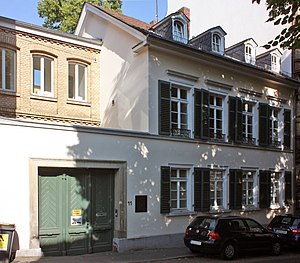 Kapellenstrasse 11 in Wiesbaden 50 ° 5 ′ 19 ″ N, 8 ° 14 ′ 31 ″ E |
| Ruhrchemie, Oberhausen | On 24 September 2013, the unveiling took place another plaque on the Ruhr Chemie in Oberhausen , where Otto Roelen the hydroformylation discovered (oxo process). Exactly 75 years before the date of the unveiling, Roelen had the process patented. |  |
 Oxea Ruhrchemie plant 51 ° 31 ′ 32 ″ N, 6 ° 47 ′ 55 ″ E |
|
| 2014 | Friedrich August Kekulé , Bonn | On May 9, 2014, the memorial plaque to honor the work of Friedrich August Kekulé was unveiled at the Old Chemical Institute of the University of Bonn |  |
 Kekulé von Stradonitz memorial in front of the Old Chemical Institute 50 ° 43 ′ 34 ″ N, 7 ° 5 ′ 30 ″ E |
| 2015 | Johannes Hartmann , Marburg | On July 10, 2015, the GDCh and the chemistry and pharmacy departments of the Philipps University of Marburg honored the work of Johannes Hartmann with a second plaque at the Old Chemical Institute. In his "Laboratorium chymicum publicum" Hartmann imparted practical chemical knowledge to his students for the first time. The building of the former chemical institute now houses the chemical center as well as the Marburg University Association, a mammography project and working groups from Foto Marburg . |  |
 Former chemical institute of the Philipps University of Marburg 50 ° 49 ′ 0 ″ N, 8 ° 46 ′ 12 ″ E |
| 2016 | Johann Wolfgang Döbereiner , Jena | In September 2016, the GDCh unveiled a plaque in honor of Johann Wolfgang Döbereiner at the Hellfeld House in Jena. The Chemical Institute had been there in Neugasse 23 since 1816, which had previously been in Jena Castle from 1811. Professor Döbereiner (1780–1849) from Jena was the inventor of platinum catalysis and the Döbereiner lighter. |  |
 Hellfeldsches Haus, Jena, Neugasse 23. 50 ° 55 ′ 29 ″ N, 11 ° 35 ′ 3 ″ E |
| 2017 | August Wilhelm von Hofmann , Berlin | In September 2017, the memorial plaque of its founding president August Wilhelm Hofmann (1818-1892) was ceremoniously unveiled as part of the Science Forum 2017 event on the occasion of the 150th anniversary of the Society of German Chemists. It is located on the square in front of the Jacob and Wilhelm Grimm Center of the Humboldt University, Geschwister-Scholl-Str. 1-3, 10117 Berlin. The actual founding place, the diorama of the Gropius brothers , had to give way to the construction of the light rail as early as 1876. |  |
 Grimm Center in Geschwister-Scholl-Strasse, near the former location of the Chemical Institute. 52 ° 31 '14 "N, 13 ° 23' 31" E |
| 2018 | Merck's Pützer Tower as an industrial monument, Darmstadt | Merck celebrates its 350th anniversary in 2018. The Pützer Tower, named after Prof. Friedrich Pützer (1871–1922), a rector, university professor, monument conservator, town planner and architect of the Technical University of Darmstadt, is considered to be its historical memorial . The tower symbolizes the connection between companies and the public. | 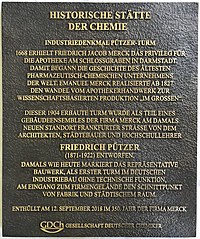 |
 Pützer tower from Merck 49 ° 53 ′ 44 ″ N, 8 ° 39 ′ 13 ″ E |
| 2019 | Old chemical laboratory of the Georg-August-Universität Göttingen | The half-timbered building was erected in 1783 and served as the chemical laboratory of the Georg August University of Göttingen until the second half of the 19th century, and as the residence of the institute directors until the 20th century. It is one of the oldest surviving university laboratories in Germany; for the University of Göttingen it was the first building specially built for a natural science subject. The first director was Johann Friedrich Gmelin , his successors Friedrich Stromeyer and Friedrich Wöhler brought the laboratory to national and international importance. |
|
 Altes Chemisches Laboratorium Göttingen 51 ° 31 ′ 49 ″ N, 9 ° 56 ′ 12 ″ E |
literature
A brochure has been published by the Gesellschaft Deutscher Chemiker for each award.
Web links
Commons : Historic Sites of Chemistry - Collection of images, videos and audio files
- Society of German Chemists: Program "Historic Sites of Chemistry" of the GDCh
Individual evidence
- ^ GDCh: Historic sites of chemistry: Justus von Liebig Gießen , May 16, 2003 (PDF; 261 kB).
- ↑ Philipps University of Marburg: Old Chemical Institute awarded as a Historic Site of Chemistry .
- ^ Chemikum Marburg: The history of the building at Bahnhofstrasse 7 , accessed on August 6, 2012.
- ↑ Brochure Historical buildings of Chemistry: Karl Ziegler (PDF) about the site at the MPI for Coal Research.
- ^ Pharmaceutical newspaper: Historic site of chemistry.
- ↑ Press release: Historic sites of chemistry - Where Bunsen researched, taught and lived
- ^ GDCh: Otto Roelen and Ruhrchemie
- ↑ Invitation flyer for the unveiling on July 10, 2015 , accessed on July 21, 2015.
- ↑ Press release from July 15, 2015 at idw , accessed on July 21, 2015.
- ^ Chemikum Marburg: The history of the building at Bahnhofstrasse 7 , accessed on August 6, 2012.
- ↑ Invitation flyer for the unveiling on September 8, 2016 , accessed on August 15, 2016.
- ↑ GDCh invitation flyer
- ↑ GDCh invitation flyer